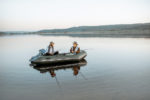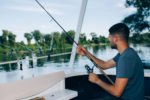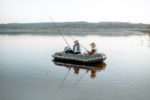How To Read a Deeper Fish Finder: A Portable, Wireless, and Castable Unit

In today’s tech-savvy world, we find ourselves in awe of the vision behind Deeper fish finders.
A truly innovative gadget, these devices have revolutionized the way we traditionally view fish finders.
Their wireless, castable, and portable design have upgraded the fishing experience by deviating from the way conventional fish finders work.
Like every cutting-edge technology, learning how to read a Deeper fish finder may take some time.
With the right attitude, you’d be well on your way to catching game in no time.
Before we talk about how you can do this, let’s start with the basics.
About Deeper
Deeper fish finders are the brainchild of two adventurous anglers impressed by the immense utility of the fish-finding technology.
While thoroughly acquainted with traditional fish finders that require installation on your vessel, the inventors set out to create something portable and castable in 2012.
After a year of consulting with tech gurus and industry professionals, they were able to turn their idea into a reality.
In 2013, the Deeper sonar technology hit the market and took everyone by surprise.
Today, the technology has spread globally to over 50 countries, with varying models and a supporting app for interpreting the readings on the go.
Getting To Know Deeper Sonars
Before we learn how to read a Deeper fish finder, it is important to understand the technology behind it first.
Since Deeper fish finders are a new type of fish finder, there are many functional differences from the traditional models.
Let’s go over the different components of a Deeper fish finder before delving into the display side of things.
How It Works
The sonar technology used in Deeper fish finders utilizes Wi-Fi technology to connect with a nearby paired device.
This strong wireless connection helps transfer information collected through sonar scans to the app on your compatible device.
This can include information ranging from the level of depth to prime fish location, as well as the features of the surface of the bottom.
The Fish Deeper application holds detailed records of past fishing trips and helps plan future ones.
Although considerably smaller in size and weighing merely 0.2 pounds, Deeper sonars are a powerful piece of technology.
They are designed to:
- Scan at a depth of 260 feet for fish and structures
- Provide 0.5-inch target separation to detect and tell apart the smallest of targets
- Provide 15 scans per minute, ensuring data from 900 scans in an hour
- Utilize two sonar beams at 30kHz ad 290kHz
Different Fishing Styles
Gone are the days when every fishing type required a different sonar system.
Deeper fish finders are portable, allowing anglers to use them on a variety of finishing adventures. These can range from shore fishing to kayaking and even trolling.
There is even a dedicated mode in the PRO and PRO+ models that allow for easy boat fishing.
Compared to sonar systems that utilize Bluetooth connectivity, these use Wi-Fi technology for a more stable and reliable connection.
Wi-Fi Connectivity
Although a big misperception, many equate the Wi-Fi technology in the Deeper fish finder with having mobile or internet connectivity.
Rather, in reality, it works like a hotspot by using a wireless connection to transfer data to your phone.
Unlike Bluetooth technology, the Deeper fish finder uses a stronger wireless signal to connect to your phone or tablet in the vicinity.
You will also find that the GPS function of the PRO+ model does not require a phone or internet connection.
Instead, it directly connects with a GPS satellite.
Perfect Casting
Casting an expensive piece of equipment into the depths of any waterbody is sure to give you some freight. You may also worry about losing the fish finder if the line snaps.
You’ll be glad to know that Deeper fish finders passed the casting test with flying colors.
It has been tested on a variety of lines, ranging from six pounds to 20 pounds, without coming apart.
Also, these are designed to float, so you can never lose them to the depths of any water body.
To ensure a flawless cast, here are some tips to consider:
- If you are casting over a short distance, it is recommended that you utilize the side-swing motion.
- Refrain from whipping at the fishing rod, especially when the Deeper fish finder is mid-air.
- A strong line and rod are recommended when casting a wider distance.
There is less than 1% chance you would spook the game-fish by casting your Deeper fish finder because of its considerably less weight.
On the contrary, fish are inquisitive in nature, so casting the fish finder will only create more of a spectacle for them.
The versatile, compact, and portable design of the Deeper fish finder allows skeptical users to cast beyond the interested region.
Similarly, shore anglers can use the river’s current to allow the Deeper to drift around.
How To Read a Deeper Fish Finder
Unlike conventional units, Deeper fish finders utilize the screen of a compatible device to transmit information via a Wi-Fi connection.
Here are some of the common features of the Fish Deeper application:
- Both bathymetric maps and sonar scans have a display header with important details that may change over the course of the fishing trip
- These include the time, depth, temperature, battery levels of the sonar, boat speed if you are on a vessel, and connectivity levels with your Deeper
- Downloadable maps for offline orientation
- Create your own bathymetric map for reference
- Real-time historical data available for checking previously scanned region without hampering current scanning
- Full control over personalizing your scanning sessions by pausing, changing, and resuming any session
- Four programmable modes for standard, ice, boat, and onshore fishing expeditions
- The displays for each mode are different depending on the level of detail required for each
- The application is compatible with both iOS and Android operating systems and available in multiple languages
While the interactive mobile application allows users to have all their data available at their fingertips at all times, it also helps read the following:
1. Identifying Fish
Based on your preferences, you can program the app’s display to show fish as an icon or via arches.
The sonar data is interpreted to identify the existence of fish, if there are any. However, these are not 100% accurate.
This is because fish do not have a predetermined pattern of swimming, resulting in haphazard readings.
Additionally, other structures like weed may get interpreted as fish.
Because of this, experienced anglers prefer to rely on interpreting the data themselves by reading fish arches.
If you are a novice angler, starting out with the fish-icon setting is the better choice.
These can vary from full to half and long to short. You can read more about the detailed interpretations of these arches.
2. Determining Fish Size
Identifying and interpreting fish arches accurately is the first step in learning about the size of the fish.
Here are some basic interpretations of arch sizes:
- A longer arch does not mean a bigger fish.
The arch length is determined by the time the fish spends within the sonar beam. Therefore, a slow swimming fish may not necessarily be a large size fish.
- Arches are interpreted horizontally. A thicker arch is a better representation of a larger fish.
- The difference between a full arch and a half arch is based on how much the fish covered the beam from the sonar cone.
- Baitfish can be identified as dashes, lines, or dots.
These can easily be mistaken for vegetation, as well. However, there are three primary differences to look out for:
- It will not be found on the bottom or closer to the bottom
- It will appear in a different color from common vegetation on your display
- It most commonly appears in cloud-like structures, like small balls
3. Identifying Structures
On the right of the screen, the app shares the depth of the water bed.
By identifying structures, you can find schools of game fish. However, these are best identified during trolling or reeling.
Depending on the type of fishing and the type of catch you are opting for, there are specific structures you may want to avoid or locate.
For instance, vegetation and weed are great places to locate bass in the summer but not so good if you are feeder fishing.
Additionally, you may want to identify depressions, especially if you are carp fishing. The V-shaped dips in your display are small depressions.
Another feature to look out for is the changing color on your display. These varying shades are crucial in helping you identify different structures, such as vegetation.
However, the shades may vary based on the mode you opt for in the Deeper application.
For instance, in the classic color mode, vegetation may appear green, while in the day color mode, it will appear purple.
Reading a Deeper Fish Finder
Reading a Deeper fish finder is much easier compared to the displays of many conventional models.
The compact and portable nature of the Deeper fish finder has broken the generations-long seal of developing standard fish finders.
The app’s interactive interface is not only user-friendly but also customizable to help get better readings from the sonar beams.
Additionally, since its compatible with iOS and Android systems, users can download it on several devices.




